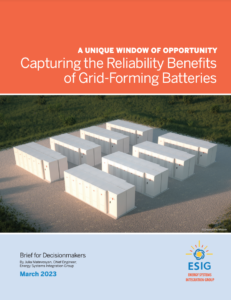Full Title: Capturing the Reliability Benefits of Grid-Forming Batteries
Author(s): Julia Matevosyan
Publisher(s): Energy Systems Integration Group
Publication Date: March 15, 2023
Full Text: Download Resource
Description (excerpt):
Implementing grid-forming (GFM) controls on new battery storage systems has the potential to increase grid reliability at low cost. As of 2021, interconnection queues in the United States contained an estimated 427 GW of battery storage capacity that, in the absence of incentives or requirements for GFM controls, will be built with conventional grid-following (GFL) controls. Some of these batteries will be deployed in weak grid areas already dominated by GFL inverter-based resources (IBRs) (wind, solar, and battery storage). Power export capability from these areas may already be limited due to stability concerns, and the integration of additional GFL IBRs in such areas is likely to further reduce stability margins (i.e., lower the power export limits) and could
create additional transmission constraints. Reductions in the export of low-cost generation from these areas will drive up overall energy costs. To relieve these stability-related power export constraints, additional transmission assets such as synchronous condensers or transmission lines will be needed, thus also driving transmission costs higher.
However, when batteries are equipped with GFM controls, rather than exacerbate weak grid issues, they can provide stability services. The advantage of implementing GFM controls in newly planned batteries is that stability can be provided by resources themselves as they are added to the system. Thus, improved stability margins can be achieved at lower cost, as these GFM resources can help avoid the need for supplemental stabilizing equipment.
While some areas—for example, the Hawaiian Islands—already have an acute need to install GFM batteries to maintain grid stability and prevent blackouts, in much of the United States and globally, IBR levels are moderate, and existing conventional power plants are still providing reliability services. This presents a unique window of opportunity to procure, test, and gain experience with GFM technology now, before the need for wind, solar, and battery storage to contribute to grid stability becomes
acute. As levels of IBRs continue to rise and stability issues become a concern for more and more regions, areas that have taken advantage of this opportunity will be able to maintain reliability through the less expensive, more efficient means of having the GFM IBRs provide stability advantages themselves.
